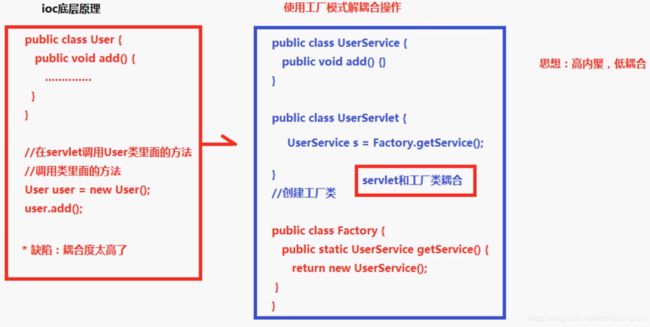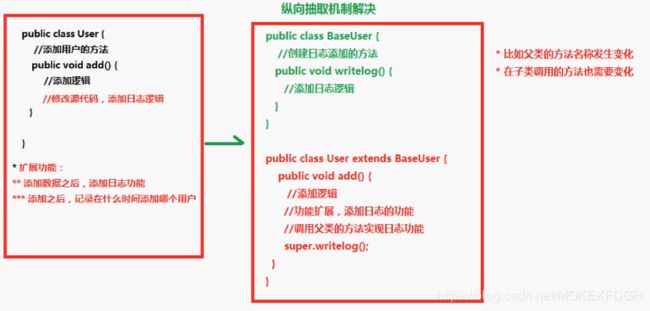SSM框架之Spring
文章目录
- Spring
- IOC
- Spring的bean管理(xml方式)
- 属性注入
- 加载spring配置文件
- Spring的bean管理(注解方式)
- 注解属性注入
- 配置文件和注解混合使用
- AOP
- Spring的aop操作
- aspectj的xml配置
- log4j和监听器
- aspectj的注解操作
- jdbcTemplate
- crud的增删改查
- spring配置连接池和dao使用jdbcTemplate(ioc)
- Spring的事务处理
- 声明式事务管理(xml)
- 声明式事务管理(注解)
Spring
1.spring是开源的轻量级框架,是一站式框架
注:使用spring最基本功能时候,需要导入四个核心的jar包+一个日志jar包
2.spring核心主要两部分:
(1)aop:面向切面编程,扩展功能不是修改源代码实现
(2)ioc:控制反转(把对象的创建不是通过new方式实现,而是交给spring配置创建类对象)
3.一站式框架:spring在javaee三层结构中都提供了不同的解决技术,即:
(1)web层:springMVC
(2)service层:spring的ioc
(3)dao层:spring的jdbcTemplate
4.SSM框架开发:Spring√+SpringMVC+Mybatis
IOC
1.ioc操作:把对象的创建交给spring进行管理
ioc的操作有两种方式:①配置文件(xml)方式;②注解方式
ioc和di的区别:
(1)ioc:控制反转
(2)di:依赖注入,即向类里面的属性中设置值(不能单独存在,需要在ioc基础之上 完成)
2.ioc的底层原理
(1)底层使用的技术:xml配置文件、dom4j解析、工厂设计模式、反射
(2)实现原理:
a.工厂模式:

b.ioc原理:

Spring的bean管理(xml方式)
1.bean实例化的三种方式:
(1)使用类的无参构造创建(重点)
<bean id="user" class="cn.test.ioc.User">bean>
(2)使用静态工厂创建
public class BeanFactory{
public static Bean getBean(){
return new Bean();
}
}
<bean id="bean" class="cn.test.ioc.BeanFactory" factory-method="getBean">bean>
(3)使用实例工厂创建
public class BeanFactory{
public Bean getBean(){
return new Bean();
}
}
<bean id="beanFacctory" class="cn.test.ioc.BeanFactory">bean>
<bean id="bean" factort-bean="beanFacctory" factory-method="getBean">bean>
2.案例
(1)配置文件:applicationContext.xml
<beans
xmlns="http://www.springframework.org/schema/beans"
xmlns:xsi="http://www.w3.org/2001/XMLSchema-instance"
xsi:schemaLocation="http://www.springframework.org/schema/beans
http://www.springframework.org/schema/beans/spring-beans-4.1.xsd">
<bean id="user" class="cn.test.ioc.User">bean>
beans>
(2)ApplicationContext加载配置文件
ApplicationContext context =
new ClassPathXmlApplicationContext("applicationContext.xml");//加载spring配置文件,创建对象
User user = (User)context.getBean("user");
3.bean的常用属性
(1)id:id属性值名称任意命名,根据id值得到配置对象
(2)class:创建对象所在类的全路径
(3)name:功能和id属性一样;区别:id不能包含特殊符号,而name可以(一般不用)
(4)scope四个属性值:
a.singleton:默认值,单例(重点,单例一个类只有一个对象)
b.prototype:多例(重点)
c.request:创建对象把对象放到request域里面
d.session:创建对象把对象放到session域里面
e.globalSession:创建对象把对象放到globalSession里面
属性注入
1.属性注入:建对象时候,向类里面属性里面设置值
2.三种注入方式:
(1)使用set方法注入√(重点)
public class User{
private String name;
public void setName(String name){
this.name = name;
}
}
(2)使用有参数构造注入√
public class User{
private String name;
public User(String name){
this.name = name;
}
}
(3)使用接口注入
public interface Dao{
public void delete(String name);
}
public class DaoImp implements Dao{
private String name;
public void delete(String name){
this.name = name;
}
}
3.spring支持的前两种注入方式:
(1)使用有参数构造注入
public class PropertyDemo{
private String username;
public PropertyDemo(String username){
this.username = username;
}
public void test(){
System.out.println("demo......");
}
}
在配置文件中注入
<bean id="demo" class="cn.test.PropertyDemo">
<constructor-arg name="username" value="moke123">constructor-arg>
bean>
(2)使用set方法注入(常用)
public class Book{
private String bookname;
public void setBookname(String bookname){
this.bookname = bookname;
}
public void demobook(){
System.out.println("book......");
}
}
在配置文件中注入
<bean id="book" class="cn.test.Book">
<property name="bookname" value="sanmao">property>
bean>
4.对象类型属性注入(重点)
例如,Service中的Dao
(1)在service里面把dao作为类型属性
(2)生成dao类型属性的set方法
(3)配置文件中注入关系
<bean id="userDao" class="cn.test.UserDao">bean>
<bean id="userService" class="cn.test.UserService">
<property name="userDao" ref="userDao">property>
bean>
5.复杂类型属性注入
(1)P名称空间属性注入:
xsi:schemaLocation="http://www.springframework.org/schema/beans
http://www.springframework.org/schema/beans/spring-beans-4.1.xsd">
<bean id="person" class="cn.test.Person" p:name="zhangsan">bean>
beans>
(2)数组、List、Map、Properties属性注入:
<bean id="demo" class="cn.test.demo">
<property name="arrs">
<list>
<value>小王value>
<value>小马value>
<value>小宋value>
list>
property>
<property name="list">
<list>
<value>小王value>
<value>小马value>
<value>小宋value>
list>
property>
<property name="map">
<map>
<entry key="a" value="小王">entry>
<entry key="b" value="小马">entry>
<entry key="c" value="小宋">entry>
map>
property>
<property name="properties">
<props>
<prop key="drivetclass">com.mysql.jdbc.Driverprop>
<prop key="username">rootprop>
props>
property>
bean>
加载spring配置文件
1.问题:在每次创建对象时都加载配置文件,会使得效率变低
2.解决:把加载配置文件和创建对象过程,在服务器启动时候完成
3.实现:
(1)ServletContext对象
(2)监听器
4.使用:
- 在服务器启动时候,为每个项目创建一个ServletContext对象
- 在ServletContext对象创建时候,使用监听器可以具体到ServletContext对象在什么时候创建
- 使用监听器监听到ServletContext对象创建时候,
加载spring配置文件,把配置文件配置对象创建
把创建出来的对象放到ServletContext域对象里面(setAttribute方法) - 获取对象时候,到ServletContext域得到 (getAttribute方法)
Spring的bean管理(注解方式)
jar:基本jar包+spring-aop的jar包
1.配置文件(新约束和开启注解扫描):
xsi:schemaLocation="http://www.springframework.org/schema/beans
http://www.springframework.org/schema/beans/spring-beans-4.1.xsd"
http://www.springframework.org/schema/context
http://www.springframework.org/schema/context/spring-context.xsd>
<context:component-scan base-package="cn.test">context:component-scan>
-->
beans>
2.注解创建对象和单例、多例注解:
@Component(value="user")//相当于3.创建对象的四个注解:
@Controller:WEB层
@Service:业务层
@Repository:持久层
注:三个为@Component的衍生注解,是为了让标注类本身的用途清晰(以后会增强)
注解属性注入
1.在service得到dao对象@Autowired:
//创建service和dao类
@Component(value="userDao")
public class UserDao{}
@Component(value="userService")
public class UserService{
//对象属性注入
@Autowired
private UserDao userDao;//注解方式不需要set方法
}
2.@Resource:需要指定注入的对象
@Resource(name="userDao")
private UserDao userDao;
配置文件和注解混合使用
1.配置文件:
<context:component-scan base-package="cn.test">context:component-scan>
<bean id="bookService" class="cn.test.BookService">bean>
<bean id="bookDao" class="cn.test.BookDao">bean>
<bean id="ordersDao" class="cn.test.OrdersDao">bean>
2.注解方式注入属性:
@Resource(name="bookDao")
private BookDao bookDao;
@Resource(name="ordersDao")
private OrdersDao ordersDao;
AOP
1.aop:面向切面(方面)编程,扩展功能不修改源代码实现
2.AOP采取横向抽取机制,取代了传统纵向继承体系重复性代码
3.aop底层使用动态代理实现
(1)第一种情况,有接口情况,使用动态代理创建接口实现类代理对象
(2)第二种情况,没有接口情况,使用动态代理创建类的子类代理对象
4.AOP原理:
(1)传统纵向机制扩展功能:extends
缺点:当父类的方法名称发生变化时,在子类调用的方法也需要变化

(2)横向扩展机制的两种情况:
a.有接口:使用动态代理方式创建接口实现类代理对象√
b.没有接口:使用cglib动态代理

5.aop操作术语
Joinpoint(连接点): 类里面可以被增强的方法,这些方法称为连接点
Pointcut(切入点):所谓切入点是指我们要对哪些Joinpoint进行拦截的定义
Advice(通知/增强):所谓通知是指拦截到Joinpoint之后所要做的事情就是通知.通知分为前置通知,后置通知,异常通知,最终通知,环绕通知(切面要完成的功能)
Aspect(切面): 是切入点和通知(引介)的结合
Introduction(引介):引介是一种特殊的通知在不修改类代码的前提下, Introduction可以在运行期为类动态地添加一些方法或Field
Target(目标对象):代理的目标对象(要增强的类)
Weaving(织入):是把增强应用到目标的过程,即把advice 应用到 target的过程
Proxy(代理):一个类被AOP织入增强后,就产生一个结果代理类
Spring的aop操作
1.在spring里面进行aop操作,使用aspectj实现
(1)aspectj不是spring一部分,和spring一起使用进行aop操作
(2)Spring2.0以后新增了对AspectJ支持
2.使用aspectj实现aop有两种方式
(1)基于aspectj的xml配置
(2)基于aspectj的注解方式
3.除了导入基本的jar包外,还需要导入aop相关的jar包
aspectj的xml配置
1.使用表达式配置切入点
execution(<访问修饰符>?<返回类型><方法名>(<参数>)<异常>)
(1)execution(* cn.itcast.aop.Book.add(…))
(2)execution(* cn.itcast.aop.Book.*(…))
(3)execution(* .(…))
(4) 匹配所有save开头的方法 execution(* save*(…))
2.配置文件:
<bean id="book" class="cn.test.aop.Book">bean>
<bean id="myBook" class="cn.test.aop.MyBook">bean>
<aop:config>
<aop:pointcut expression="execution(* cn.test.aop.Book.*(...))" id="pointcat1"/>
<aop:asepect ref="myBook">
<aop:before method="before1" pontcut-ref="pointcat1"/>
<aop:after-returning method="after1" pontcut-ref="pointcat1"/>
<aop:around method="around1" pontcut-ref="pointcat1"/>
aop:asepect>
aop:aspect>
beans>
3.被增强类和增强类:
public class Book{
public void add(){
System.out.println("add....");
}
}
public class MyBook{
public void before1(){
System.out.println("前置增强...");
}
public void after1(){
System.out.println("后置增强...");
}
public void around1(ProceedingJoinPoint proceedingJoinPoint){//环绕通知
System.out.println("方法之前...");
proceedingJoinPoint.proceed();//执行被增强的方法
System.out.println("方法之后...");
}
}
log4j和监听器
1.log4j
作用:可以看到程序运行过程中更详细的信息,例如日志信息
使用:导入log4j包并复制log4j的配置文件,复制到src下
配置文件:
设置日志级别->log4j,rootLogger=info,stdout
info:看到基本信息;debug:看到详细信息
2.监听器:spring中只需要配置监听器即可
(1)导入spring-web项目jar包
(2)在web.xml配置监听器
<listener>
<listener-class>org.springframework.web.context.ContextLoaderListenerlistener-class>
listener>
(3)在applicationContext.xml指定加载spring配置文件位置
<context-param>
<param-name>contextConfigLocationparam-name>
<param-value>classpath:applicationContext.xmlparam-value>
context-param>
aspectj的注解操作
1.创建对象并开启aop操作
<bean id="book" class="cn.test.aop.Book">bean>
<bean id="mybook" class="cn.test.aop.MyBook">bean>
<aop:aspectj-autoproxy>aop:aspectj-autoproxy>
2.在增强类上使用注解完成aop操作
@Aspect
public class MyBook{
@Before(value="execution(* cn.test.aop.Book.*(...))")
public void before(){
System.out.println("before...")
}
}
jdbcTemplate
1.spring框架一站式框架
(1)针对javaee三层,每一层都有解决技术
(2)在dao层,使用jdbcTemplate
注:spring对不同的持久化层技术都进行封装,jdbc封装为jdbcTemplaye
jdbcTemplate使用和dbutils使用很相似,都是对数据库进行crud操作
导入spring-jdbc和spring-tx的jar包以及数据库驱动
crud的增删改查
1.增删改
DriverManagerDataSource dataSource = new DriverManagerDataSource();
dataSource.setDriverClassName("com.mysql.jdbc.Driver");
dataSource.setUrl("jdbc:mysql:///spring_day03");
dataSource.setUsername("root");
dataSource.setPassword("root");
//创建jdbcTemplate对象
JdbcTemplate jdbcTemplate = new JdbcTemplate(dataSource);
//调用update方法实现删除
String sql = "delete from user where username=?";//删除
//修改:String sql = "update user set password=? where username=?";
//添加:String sql = "insert into user values(?,?)";
int rows = jdbcTemplate.update(sql, "lucy");
System.out.println(rows);
2.查询
jdbcTemplate实现查询有RowMapper(dbutils有ResultSetHandler且有实现类),这个接口没有提供实现类
查询具体实现:
(1)查询返回某个值:queryForObject(String sql,Class requiredType)
String sql = "select count(*) from user";
//调用jdbcTemplate的方法
int count = jdbcTemplate.queryForObject(sql, Integer.class);
(2)查询返回某一个对象:queryForObject(String sql,RowMapper rowMapper,Object…args)
String sql = "select * from user where username=?";
//调用jdbcTemplate的方法实现
//第二个参数是接口 RowMapper,需要自己写类实现接口,自己做数据封装
User user = jdbcTemplate.queryForObject(sql, new MyRowMapper(), "mary");
System.out.println(user);
//接口实现类,实现mapRow方法
class MyRowMapper implements RoMapper<User>{
public User mapRow(ResultSet rs,int num) throws SQLException{
//从结果集里面得到数据
String username = rs.getString("username");
String password = rs.getString("password");
//将数据封装到对象里面
User user = new User();
user.setUsername(username);
user.setPassword(password);
return user;
}
}
(3)查询返回一个List集合:query(String sql,RowMapper rowMapper,Object…args)
String sql = "select * from user";
List<User> userList = jdbcTemplate.query(sql, new MyRowMapper());//和上面的实现类一样
spring配置连接池和dao使用jdbcTemplate(ioc)
1.配置连接池
<bean id="dataSource" class="com.mchange.v2.c3p0.ComboPooledDataSource">
<property name="driverClass" value="com.mysql.jdbc.Driver">property>
<property name="jdbcUrl" value="jdbc:mysql:///spring_day03">property>
<property name="user" value="root">property>
<property name="password" value="root">property>
bean>
<bean id="userDao" class="cn.itcast.c3p0.UserDao">
<property name="jdbcTemplate" ref="jdbcTemplate">property>
bean>
<bean id="jdbcTemplate" class="org.springframework.jdbc.core.JdbcTemplate">
<property name="dataSource" ref="dataSource">property>
bean>
2.dao使用jdbcTemplate
public class UserDao{
private JdbcTemplate jdbcTemplate;
public void setJdbcTemplate(JdbcTemplate jdbcTemplate){
this.jdbcTemplate = jdbcTemplate;
}
}
Spring的事务处理
1.spring事务管理两种方式
第一种、编程式事务管理(不用)
第二种、声明式事务管理
(1)基于xml配置文件实现
(2)基于注解实现
spring事务管理的api介绍:3个接口,PlatformTraansactionManager(管理器)
注:spring针对不同的dao层框架,提供接口不同的实现类
声明式事务管理(xml)
<beans xmlns="http://www.springframework.org/schema/beans"
xmlns:xsi="http://www.w3.org/2001/XMLSchema-instance"
xmlns:context="http://www.springframework.org/schema/context"
xmlns:aop="http://www.springframework.org/schema/aop"
xmlns:tx="http://www.springframework.org/schema/tx"
xsi:schemaLocation="http://www.springframework.org/schema/beans
http://www.springframework.org/schema/beans/spring-beans.xsd
http://www.springframework.org/schema/context
http://www.springframework.org/schema/context/spring-context.xsd
http://www.springframework.org/schema/aop
http://www.springframework.org/schema/aop/spring-aop.xsd
http://www.springframework.org/schema/tx
http://www.springframework.org/schema/tx/spring-tx.xsd">
<bean id="dataSource" class="com.mchange.v2.c3p0.ComboPooledDataSource">
<property name="driverClass" value="com.mysql.jdbc.Driver">property>
<property name="jdbcUrl" value="jdbc:mysql:///spring_day03">property>
<property name="user" value="root">property>
<property name="password" value="root">property>
bean>
<bean id="transactionManager" class="org.springframework.jdbc.datasource.DataSourceTransactionManager">
<property name="dataSource" ref="dataSource">property>
bean>
<tx:advice id="txadvice" transaction-manager="transactionManager">
<tx:attributes>
<tx:method name="account*" propagation="REQUIRED"/>
tx:attributes>
tx:advice>
<aop:config>
<aop:pointcut expression="execution(* cn.itcast.service.OrdersService.*(..))" id="pointcut1"/>
<aop:advisor advice-ref="txadvice" pointcut-ref="pointcut1"/>
aop:config>
<bean id="ordersService" class="cn.itcast.service.OrdersService">
<property name="ordersDao" ref="ordersDao">property>
bean>
<bean id="ordersDao" class="cn.itcast.dao.OrdersDao">
<property name="jdbcTemplate" ref="jdbcTemplate">property>
bean>
<bean id="jdbcTemplate" class="org.springframework.jdbc.core.JdbcTemplate">
<property name="dataSource" ref="dataSource">property>
bean>
beans>
声明式事务管理(注解)
<bean id="transactionManager" class="org.springframework.jdbc.datasource.DataSourceTransactionManager">
<property name="dataSource" ref="dataSource">property>
bean>
<tx:annotation-driven transaction-manager="transactionManager"/>
在要使用事务的方法所在类上面添加注解:
@Transactional
public class OrdersService{
...
public void accountMoney(){//要使用事务的方法
...
}
}